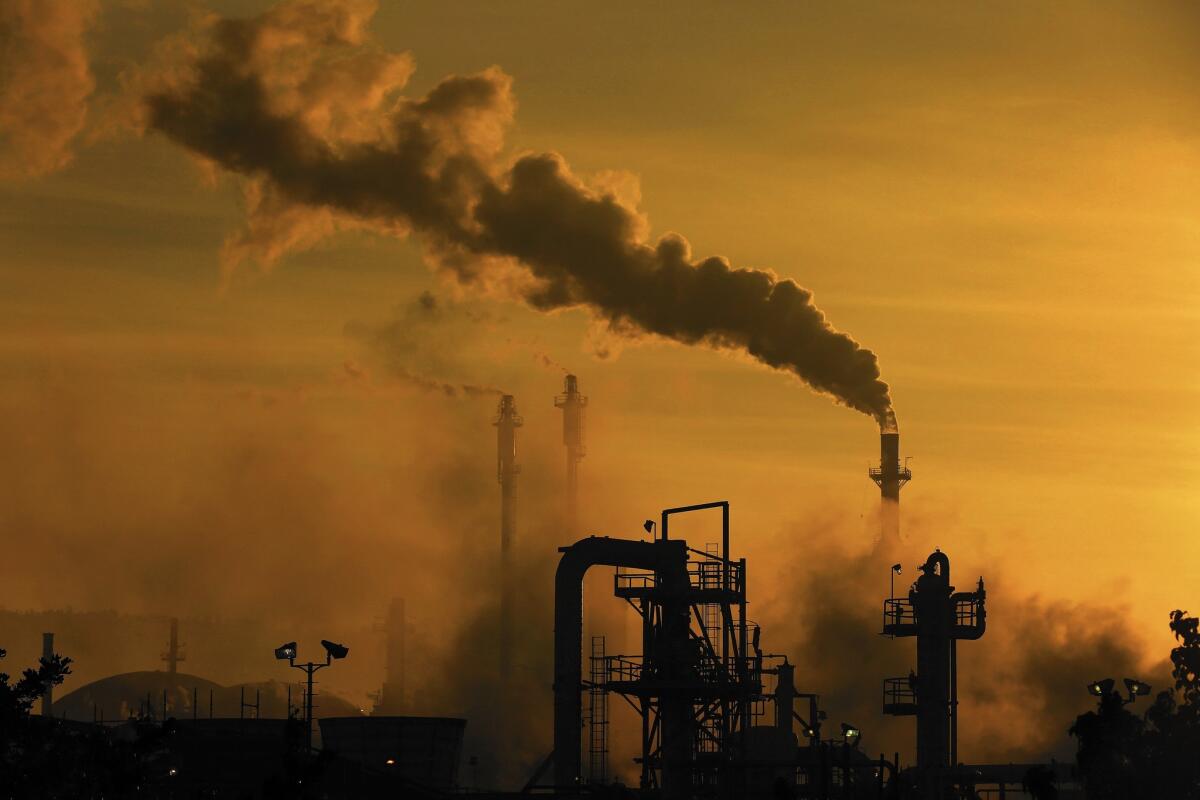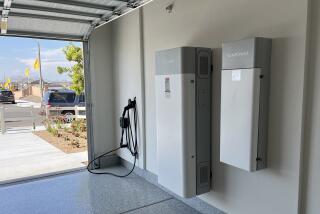How the refineries came to own our air pollution regulators

“Regulatory capture” is the term for what happens when an agency overseeing an industry begins to see things the industry’s way. Consider the most recent illustration: the South Coast Air Quality Management District board and the refinery industry.
The refineries are among the worst-polluting facilities in the Southland, which has the dirtiest air in the United States. But that didn’t stop the board from rejecting on Dec. 4 a clean-air plan worked out by its staff over 37 months and substituting a plan made public that very morning, developed by the Western States Petroleum Assn., a refinery lobbying group.
Given a chance to reconsider its action at a meeting earlier this month, the board voted to stand pat. At the same meeting it fired its executive officer, Barry Wallerstein, who had supported the staff proposal.
These actions have landed the AQMD board in a world of hurt. The board, which is composed of 13 local politicians and business leaders representing Los Angeles, Orange, San Bernardino and Riverside counties, has been upbraided by the California Air Resources Board’s executive officer, Richard Corey. He says the clean-air program would be so lax it might well violate state and federal regulations.
State Senate President Pro Tem Kevin de León (D-Los Angeles) has launched an effort to remake the board so its pollution-tolerant majority can be outvoted. On Wednesday, the Sierra Club and three other environmental organizations sued in state court to force the board to reverse its vote.
In response, the board majority and its industry overlords have offered some of the most fatuous defenses heard from a public body in years.
Board member Mike Antonovich, a Los Angeles County supervisor, informed me in an emailed statement that the AQMD board “is not simply a rubber stamp for District staff.” That’s true, but it doesn’t explain why it should be a rubber stamp for the refinery industry.
Orange County Supervisor Shawn Nelson, who sponsored the initial Dec. 4 motion to accept the industry proposal, argued that the plan does reduce emissions, just not as much as the staff proposal. He observed that the AQMD has no control over cars and trucks, the major source of air pollution. “If we put every company we regulate out of business tomorrow, we still wouldn’t meet the clean air mandate,” he said. That’s hardly an excuse for falling short on the sources it does regulate, which are stationary facilities.
As for the refinery group, its president, Catherine Reheis-Boyd, claimed in an email that the plan adopted by the board amounted to “90% of what was proposed by staff” and that the rejected proposal would have cost the industry more than $1 billion. Both figures are exaggerations, and even on the surface not especially relevant to the task of reducing emissions to levels that save lives and reduce the cost of dirty air to society.
Nor are those costs evenly distributed. Wilmington and West Long Beach, which are bordered by refineries and the ports of Los Angeles and Long Beach, have some of the highest rates of childhood asthma in the region or state. Some 15% of Long Beach children suffer from the condition, compared with 8% in the county overall. Nitrogen oxides, an asthma trigger, is among the pollutants at issue in the clean air plan.
Refineries, which account for 60% of nitrogen oxide emissions in the Southland, have managed to game air-quality standards.
The debate at the AQMD concerns the RECLAIM program (for “Regional Clean Air Incentive Market,”), a cap-and-trade system the AQMD created in 1993. Instead of directly ordering every pollution-emitter to install clean-air equipment, RECLAIM established a market in pollution credits; a power plant, cement plant or refinery that met or exceeded its clean-air goals could defray its costs by selling its excess pollution allowances to facilities that hadn’t met their goal, and could use the purchased credits to buy time. RECLAIM wasn’t supposed to give polluters a break on meeting clean-air standards, just more flexibility in how they did so.
Things haven’t worked out that way. “What we’ve seen over time is that RECLAIM has deep, deep flaws,” says Evan Gillespie of the Sierra Club. The biggest flaw is that the market is flooded with excess credits. They’re so cheap that it’s much more economical for a polluter to buy credits than to install clean-air equipment. That has slowed the pace of environmental improvement.
The refineries are the principal offenders. Electrical generating plants, which also were big players in RECLAIM, have largely been forced by their own regulators to install the necessary equipment. California Portland Cement’s Colton plant, which had been the largest single source of nitrogen oxides, shut down in 2013. That could have had a big impact on the air, but its pollution credits remained in the market, allowing other polluters to use them to avoid cutting their own emissions.
The AQMD staff calculated in 2005 that refineries would have to install 51 catalytic reduction units by 2011 to meet clean-air standards. Thanks to RECLAIM, however, only four were installed — and those as a result of orders from the federal Environmental Protection Agency. Avoiding the other 47 installations saved the refinery industry $205 million, the AQMD staff estimated.
Under RECLAIM, industries were expected to reduce their nitrogen oxide emissions by 7.7 tons per day in 2007-11. By 2012, the reduction had come to only 4 tons — mostly because of industry shutdowns, “not measures taken to reduce actual emissions,” the staff reported.
To bring the available credits more in line with emissions, the AQMD staff proposed at the December meeting to “shave” the total credits by 14 tons per day through 2022. The hope is that the price of credits would rise, making them more expensive than installing clean-air equipment.
The staff also recommended front-loading the shave, starting with 4 tons per day this year, followed by 2 tons more each year from 2018 through 2022. The staff chose this schedule because the 2016 reduction could be achieved simply by cutting excess credits out of the market. No installation of equipment would be needed — another pro-industry step. Most important, the staff proposed that credits attached to shutdown facilities be extinguished.
But the refinery group wouldn’t have it. The Western States Petroleum Assn. proposed instead a shave of only 12 tons per day, back-loaded so that the most substantial reductions wouldn’t kick in until after 2020. The industry also persuaded the AQMD board to refer the elimination of credits from closed facilities to a “working group,” which as everyone knows is where such proposals go to die.
Let’s be clear: Only one plan is based on analysis of the past and the potential to meet future clean-air mandates. The other plan achieves nothing but relief for the industry, at the expense of everyone in the Los Angeles Basin.
Supervisor Nelson says the board’s decision has been misrepresented as a sop to the refineries. “This narrative that we’re giving ‘olly-olly-oxen-free’ to polluters is just fiction,” he told me.
But the proof is in the results. RECLAIM has failed, and the AQMD should be replaced with a body that serves the public interest, not just one industry’s interest.
Michael Hiltzik’s column appears every Sunday. Read his blog every day at latimes.com/business/hiltzik, reach him at mhiltzik@latimes.com, check out facebook.com/hiltzik and follow @hiltzikm on Twitter.







